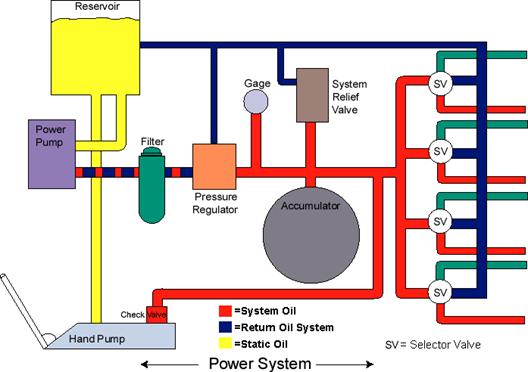





Published on Feb 14, 2025
It is a system where liquid under pressure is used to transmit this energy. Hydraulic systems take engine power and convert it to hydraulic power by means of a hydraulic pump. This power can be distributed throughout the airplane by means of tubing that runs through the aircraft. Hydraulic power may be reconverted to mechanical power by means of an actuating cylinder, or turbine.
(1) - A hydraulic pump converts mechanical power to hydraulic power
(2) - An actuating cylinder converts hydraulic power to mechanical power
(3) - Landing Gear
(4) - Engine power (mechanical HP)
If an electrical system were used instead of a hydraulic system, a generator would take the place of the pump and a motor would take the place of the actuating cylinder
Part of the hydraulic system is the actuating cylinder whose main function is to change hydraulic (fluid) power to mechanical (shaft) power. Inside the actuating cylinder is a piston whose motion is regulated by oil under pressure. The oil is in contact with both sides of the piston head but at different pressures. High pressure oil may be pumped into either side of the piston head.
The selector valve determines to which side of the actuating cylinder the high pressure oil is sent. The piston rod of the actuating cylinder is connected to the control surface. As the piston moves out, the elevator moves down. As the piston moves in, the elevator moves up. The selector valve directs the high pressure oil to the appropriate side of the piston head causing movement of the piston in the actuating cylinder. As the piston moves, the oil on the low pressure side returns to the reservoir since return lines have no pressure!
The differential in oil pressure causes movement of the piston. The force generated by this pressure difference can be sufficient to move the necessary loads. Each cylinder in the plane, boat, etc., is designed for what it must do. It can deliver the potential it was made for; no more, no less. Air loads generally determine the force needed in aircraft applications.
A hydraulic system transmits power by means of fluid flow under pressure. The rate of flow of the oil through the system into the actuating cylinder will determine the speed with which the piston rod in the actuating cylinder extends or retracts. When the cylinder is installed on the aircraft, it is already filled with oil. This insures that no air bubbles are introduced into the hydraulic system, which can adversely affect the operation of the system.
In a confined stationary liquid, neglecting the effect of gravity, pressure is distributed equally and undiminished in all directions; it acts perpendicular to the surface it touches. Because the actuating cylinder is not vented, the force delivered through the piston to the surface of the fluid is translated into a pressure on the surface of the fluid.
The pressure (p) acting on the incompressible oil does work [(pressure) x (Area of piston) x (piston's stroke) = Work].
Hydraulic Pressure Regulated Power System
The system in drawing below represents a pressure regulated power system comprised of two parts:
1) the power system, and
2) the actuating system part of the overall hydraulic system.

1. Reservoir -- holds an extra supply of fluid for system from which oil was drawn when needed, or oil was returned to it when not needed.
2. Accumulator -- absorbs pulsation within the hydraulic system and helps reduce "linehammer effects" (pulses that feel and sound like a hammer has hit the hydraulic tubes). It is an emergency source of power and it acts as another reservoir.
3. Filter -- removes impurities in the hydraulic system and in the reservoir. The reservoir has one big filter inside the tank.
4. Power Pump -- it changes mechanical horsepower (HP) to hydraulic HP.
5. System Relief Valve -- relieves pressure on system as a safety.measure and takes over as a pressure regulator when pressure regulator fails.
6. Pressure Regulator -- as the name implies, regulates the pressure in the hydraulic system. When it senses a built-up in pressure in the lines to the selector valves, it acts so that the system automatically goes to bypass.
4.Aircraft Hydraulic System Reservoir
1. Provides air space for expansion of the oil due to temperature changes
2. Holds a reserve supply of oil to account for
a. thermal contraction of oil.
b. normal leakage - oil is used to lubricate piston rods and cylinder seals. When the piston rod moves, it is scraped to remove impurities that might collect on the rod when returning into actuating cylinders. If many actuating cylinders are operating at the same time, then the amount of oil lost is greater.
c. emergency supply of oil - this case occurs only when the hand pump is used.
d. volume changes due to operational requirements - oil needed on side 2 of piston head is less than that needed on side 1 of cylinder piston (which occurs during actuation).
3. Provides a place to remove air or foam from liquid.
4. Provide a pressure head on the pump, that is, a pressure head due to gravity and depends upon the distance of the reservoir above the power pump.
The best shape is a domed cylindrical shape. Not only can it be mounted easily, but it can be made to order.
| Are you interested in this topic.Then mail to us immediately to get the full report.
email :- contactv2@gmail.com |